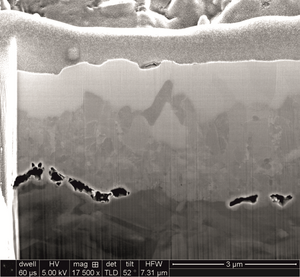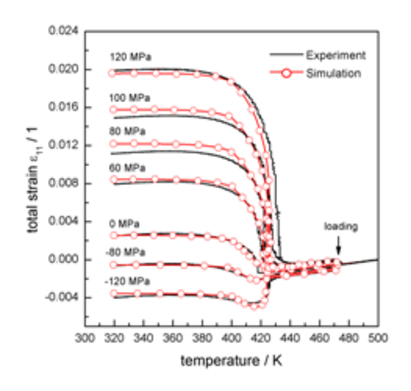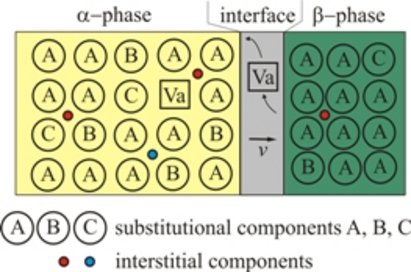Phenomena Related to Solid-Solid Phase Transformation
Couples and Pairs
The formation of couples and pairs has been introduced by extending the classical ideal solution model for the Gibbs energy to a regular solution model taking into account short ordering of atoms (couples and pairs). Application to an Al-Mg-Si alloy is demonstrated by studying the formation of Mg-Mg, Si-Si pairs and Mg-Si couples.
Martensite Formation in Nanostructures NiTi Shape Memory Alloys
Martensite Formation in Nanostructured NiTi Shape Memory Alloys
Nanostructured NiTi Shape Memory Alloys exhibit superior fatigue properties compared to their coarse-grained counterpart. Grain sizes in the order of fractions of a micrometer can be achieved by severe plastic deformation and subsequent annealing. The martensite morphology that appears after transformation is widely influenced by the grain size as can be proven by evaluating the total energy input into the system including interface energy contributions as well as the strain energy, the latter being evaluated numerically for various 3D configurations, see the attached figure. The energy-minimizing configuration is then compared with HRTEM experiments performed by T. Waitz, Physics of Nanostructured Materials, Department of Physics, University of Vienna.
Transformation Induced Plasticity
Transformation Induced Plasticity
The phenomenon of Transformation Induced Plasticity (TRIP) is studied on the example of a maraging steel by the brand name Marval X12 which has thoroughly been investigated in a series of experiments carried out at the Tokyo Metropolitan Institute of Technology. Our goal is to develop a constitutive model that eventually allows the reliable prediction of residual stresses in structural components. In the particular case of martensitic transformation the selection of variant favorably oriented relative to the stress direction gives rise to what is referred to as orientation effect which, in turn, leads to transformation related backstress effects similar to what is known in classical plasticity of kinematically hardening materials. Eventually the constitutive model should be able to reproduce the experimentally determined strain response given arbitrary external thermo-mechanical loading conditions, see the attached figure.
Diffusive Phase Transformation
Diffusive Phase Transformation
The microstructural changes connected with phase transformations determine the properties of the evolving materials. A basic understanding of the transformation kinetics is required to obtain the desired microstructure and to design functionally oriented materials. The transformation kinetics depends on diffusion of components in the bulk materials and on the rearrangement of the lattice characterized by the interface mobility [1-3]. In addition diffusion processes in the interface frequently influence the kinetics of solid/solid phase transformations. The evolution equations for all variables describing the system are derived from the principle of maximum dissipation [4].
[1] E. Gamsjäger: Pure and Applied Chemistry 83 (2011), 1105-1112.
[2] J. Svoboda, E. Gamsjäger: Int. J. Mater. Res. 102 (2011), 666-673.
[3] E. Gamsjäger: Acta Mater. 55 (2007) 4823-4833.
[4] J. Svoboda, I. Turek, F. D. Fischer: Phil. Mag. 85 (2005) 3699-3707.





